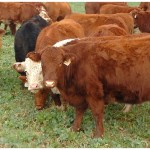Another reason why Grassfed Farms Raises Grass Fed Beef
Grass-fed vs. Grain-fed beef: Ditching the red meat and cholesterol myth

We are what we eat and this applies to cows too. Nowadays, cows are primarily fed grains but our ancestors consumed the meat of cows that ate grass and roamed free.

The nutrient composition in beef varies according to what cows are fed. Just like we pay attention to what we eat, it is important to consider what the animals we consume eat as well.
Most cows start with similar lives with the calves consuming the milk of their mothers. They are allowed to freely roam around and have grass, shrubs and other edible plants in their surrounding environment. After a period of 6 to 12 months, cows are raised conventionally and moved to feedlots where they are fed grain-based foods usually made with corn or soy. In addition, conventionally raised cattle are also given hormones, drugs and antibiotics to grow faster and become resistant to diseases that are likely to occur in unsanitary conditions.
On the other hand, grass-fed cows spend their lifetime consuming grass on grasslands and here’s why this matters:
- Omega 6 and omega 3 fatty acid composition
Omega 3s and omega 6s come under the category of polyunsaturated fatty acids (PUFAs). Although both grass-fed and grain-fed varieties consist of the same omega 6 fatty acid levels, grass-fed beef contains more omega 3 fatty acids [1], [2]. According to recent research, grass-fed beef packs a whooping omega 3-punch, containing 2 to 5 times more of the good fat than grain fed beef.
- Saturated fat levels
Red meat consists of three major types of saturated fat: stearic acid, myristic acid and palmitic acid. Grass-fed beef contains more stearic acid than grain-fed and according to research; stearic acid does not elevate cholesterol levels [3]. This has a major impact on the saturated fat composition in both meat varieties as having higher levels of stearic acid means that grass-fed meat contains lower proportions of myristic acid and palmitic acid, both of which raise cholesterol levels in the blood [4].
- Conjugated linoleic acid
Conjugated linoleic acid is another type of PUFA, which is found in milk and meat products. Conjugated linoleic acid has powerful antioxidant properties in the blood, thus being able to protect the body against diabetes, heart disease, cancer and other major chronic illnesses.
Beef is one of the riches sources of conjugated linoleic acid, with grass-fed beef containing about two to three times more of this PUFA than its grain-fed counterpart [5].
- Vitamins and minerals
Grass-fed beef consists of incredibly high levels of antioxidants, vitamins and minerals compared to grain-fed meat [6]. Since grain-fed cows do not consume much grass, their meat has lower levels of carotenoids (these are converted to vitamin A in our bodies) which are pigments in plants.
The fat of both beef varieties can be a good indicator of the nutrient-density of the meat. Carotene is a yellowish pigment so consumption of grass rich in carotenoids makes the fat more yellow in cows [7]. The yellower, the better!

Grass-fed beef consists of considerably higher levels of vitamin E, superoxide dismutase (SOD), catalase, glutathione and is rich in minerals such as iron, zinc, potassium, phosphorous and sodium [8].
Since grass-fed beef is rich in antioxidants, it is important that you do not overcook the meat to preserve its potent heart-healthy properties [9]. The antioxidants play a major role in protecting our cells against free radical damage that may increase risk of premature aging, heart disease, osteoporosis and cancer [10].
Takeaway
Still think beef is unhealthy and may cause heart disease? It’s time you dump this myth and have a nice juicy grass-fed steak straight from Grassfed Farms!
This is not intended to be medical advice. Please discuss the benefits of grassfed beef with your health care provider.
